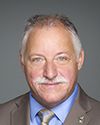That's a fantastic question. It's a huge dilemma for our public organizations that serve veterans.
Fortunately, within the system there are some extremely.... Particularly the Military Veteran Peer Network is a state-wide initiative that specifically goes to rural communities to which veterans return, and it connects them to institutional services, be those state agencies or other non-profits that may be headquartered there, which can provide them the services they need.
Also, the VA outpatient system—they call it the CBOCs, the community-based outpatient clinic system—is specifically punched out to areas from which it's too far to drive to the VA hospital for just routine medical appointments and mental health appointments. It makes sure that they are connected into those organizations and that they also have access to such opportunities as the 211 hotline, which covers the entire state here in Texas—Louisiana, our neighbours here, have a similar program—and that they are then triaged and sent to organizations that have the appropriate geographic coverage in that rural area.
It's not perfect. We're working on funding streams so as to be able to send more outreach workers to engage veterans in those rural communities, because the gap in the access to services, as you mentioned, sir, is a significant problem. This is the area in which we're seeing many of the more chronic mental health issues arise, because employment is down and entrepreneurship is down. We need to be more proactive on the front end and get out in front of those veterans.





